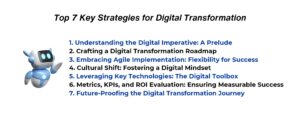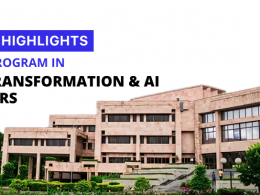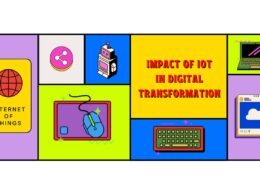In the heart-pounding race through the digital age, the pursuit of Digital Transformation transcends is a necessity for businesses to stay competitive and relevant.
Digital transformation strategies have become the compass guiding organizations through the complexities of the digital age. In this comprehensive guide, we explore the key strategies that pave the way for a successful digital transformation journey.
1. Understanding the Digital Imperative: A Prelude
Digital transformation is not just a buzzword; it’s a seismic shift reshaping industries across the globe. Before delving into strategies, let’s establish a foundational understanding of the digital imperative:
- Definition: Digital transformation involves leveraging digital technologies to fundamentally change business processes, culture, and customer experiences.
- Why Now? Rapid technological advancements, changing customer expectations, and the need for operational efficiency are driving organizations to embrace digital transformation.
2. Crafting a Digital Transformation Roadmap
A successful digital transformation journey begins with a well-defined roadmap. This strategic approach ensures that organizations move purposefully toward their digital goals. Here’s how to craft an effective roadmap:
Assessment Phase
- SWOT Analysis: Conduct a comprehensive analysis of Strengths, Weaknesses, Opportunities, and Threats to identify internal and external factors impacting your digital journey.
- Current State Evaluation: Evaluate existing processes, technologies, and cultural factors to pinpoint areas requiring transformation.
Vision and Objectives:
- Define Clear Objectives: Establish specific, measurable, achievable, relevant, and time-bound (SMART) objectives aligned with the organization’s vision.
- Cultural Alignment: Ensure that digital transformation goals align with the organizational culture.
3. Embracing Agile Implementation: Flexibility for Success
Agility is the name of the game in the digital era. Traditional, rigid approaches no longer suffice. Organizations must adopt agile methodologies for nimble and adaptive transformations:
Agile Principles:
- Iterative Development: Break down the transformation into manageable iterations, allowing for continuous improvement.
- Cross-Functional Teams: Foster collaboration among diverse teams to enhance problem-solving and innovation.
Continuous Feedback Loop:
- User Feedback: Regularly collect feedback from end-users to refine digital solutions.
- Data-Driven Decision-Making: Leverage data analytics to make informed decisions throughout the transformation process.
4. Cultural Shift: Fostering a Digital Mindset
A successful digital transformation extends beyond technology, it requires a cultural shift. Organizations must cultivate a digital mindset among employees:
Employee Empowerment:
- Training Programs: Implement comprehensive training programs to upskill employees in digital technologies.
- Leadership Support: Ensure leadership actively promotes and embodies a digital-first mindset.
Innovation Ecosystem:
- Encourage Experimentation: Foster a culture where experimentation and calculated risk-taking are encouraged.
- Recognize and Reward Innovation: Incentivize and recognize innovative efforts to drive a culture of continuous improvement.

5. Leveraging Key Technologies: The Digital Toolbox
Digital transformation is empowered by cutting-edge technologies. Organizations must strategically leverage these tools to drive meaningful change:
Cloud Computing:
- Scalability: Harness the scalability of cloud solutions for efficient and flexible operations.
- Cost Optimization: Optimize costs through pay-as-you-go models and reduced infrastructure expenses.
Internet of Things (IoT):
- Connected Ecosystems: Build interconnected ecosystems that enhance data flow and enable real-time decision-making.
- Predictive Analytics: Leverage IoT data for predictive analytics, anticipating trends and optimizing processes.
Artificial Intelligence (AI) and Machine Learning (ML):
- Automation: Implement AI-driven automation to streamline repetitive tasks and boost efficiency.
- Predictive Insights: Utilize ML algorithms for predictive insights, enhancing decision-making capabilities.
6. Metrics, KPIs, and ROI Evaluation: Ensuring Measurable Success
Measuring the success of digital transformation is crucial for ongoing improvement and demonstrating the value of the initiatives. Key performance indicators (KPIs) and Return on Investment (ROI) play a pivotal role:
Defining KPIs:
- Customer Satisfaction: Measure improvements in customer satisfaction through feedback and surveys.
- Operational Efficiency: Track enhancements in operational efficiency, reducing costs and time.
ROI Evaluation:
- Financial Metrics: Assess the financial impact, including cost savings and revenue growth.
- Time-to-Value: Evaluate how quickly digital initiatives deliver tangible value to the organization.
7. Future-Proofing the Digital Transformation Journey
The digital landscape is ever-evolving, requiring organizations to future-proof their strategies. Consider these elements for ongoing success:
Cybersecurity Integration:
- Security by Design: Infuse security measures into the digital transformation process from the outset.
- Employee Training: Educate employees on cybersecurity best practices to mitigate risks.
Scalability and Flexibility:
- Scalable Architectures: Design digital solutions with scalability in mind to accommodate future growth.
- Adaptability: Foster a culture of adaptability to seamlessly integrate emerging technologies.
Conclusion
Digital transformation is not a one-time project; it’s an ongoing journey. Organizations that embrace a holistic approach, aligning technology, culture, and strategy, position themselves for sustained success in the digital era.
If you are set to digitally transform yourself and your workspace, then do not wait. Join the XLRI Executive program in Digital Transformation today!






